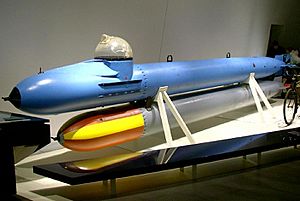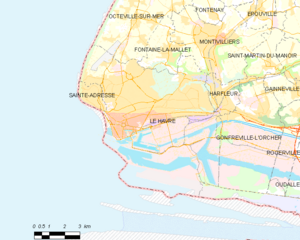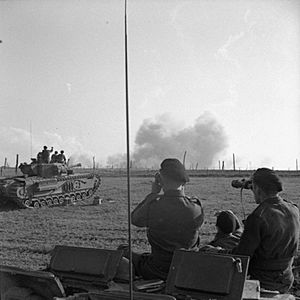Operation Astonia facts for kids
Quick facts for kids Operation Astonia |
|||||||
|---|---|---|---|---|---|---|---|
| Part of The Western Front in the Second World War | |||||||
 Churchill bridgelayers, Shermans and infantry following the assault on Le Havre, 13 September 1944 |
|||||||
|
|||||||
| Belligerents | |||||||
| Commanders and leaders | |||||||
| Strength | |||||||
|
|||||||
| Casualties and losses | |||||||
| 388–500 40 armoured vehicles |
600 killed 11,300 captured |
||||||
| 5,000 French civilians killed | |||||||
Operation Astonia was the name for an important attack by the Allied forces during World War II. It took place in September 1944 in Le Havre, a port city in France. The goal was to capture Le Havre from the German army.
The German leader, Hitler, had called Le Havre a Festung (fortress). This meant it had to be defended to the very end. The Allies wanted to take control of the port quickly. They needed it to bring supplies to their armies fighting in Continental Europe.
Before the main attack, Royal Navy ships and Royal Air Force planes bombed the city. This happened from August 26 to September 10. Sadly, many French civilians were killed during these bombings. On September 10, British soldiers began their ground attack. They had help from special armoured vehicles, including some from Canadian troops. The German soldiers, about 11,000 of them, surrendered on September 12. The port was badly damaged, but it was fixed and reopened on October 9.
Contents
Operation Astonia: A Key Battle
Why Le Havre Was Important
Le Havre was a very important port city in France. It was second only to Marseille in how many ships it could handle. It had many miles of docks for large ocean-going ships. The Allies needed this port to bring in supplies for their armies.
Early Events in Normandy
The Allies landed in Normandy, France, on D-Day, June 6, 1944. This was part of Operation Overlord, which began the liberation of France. On D-Day, Allied planes created a smoke screen near Le Havre. This was to hide their ships from German coastal guns.
German torpedo boats and small patrol ships left Le Havre. They used the smoke to hide. They fired torpedoes and sank one Allied ship, HNoMS Svenner. Later, small German submarines called Neger midget submarines attacked. Many of these tiny submarines were sunk by Allied ships.
Air and Sea Attacks Begin
RAF Bomber Command attacked Le Havre on June 14. Many 617 Squadron Lancaster bombers dropped huge Tallboy bombs. These bombs hit German E-boat pens, which were shelters for fast attack boats. This attack greatly reduced the German E-boat threat.
More bombers followed, dropping thousands of tons of bombs. This was the biggest daytime raid by Bomber Command at that time. The German anti-aircraft guns could not fire during this raid. This was because German planes were in the area. The bombing destroyed many German ships and killed many German marines.
Admiral Theodor Krancke, a German naval leader, called the raid a disaster. He said it would be hard to carry out future operations. By the end of July, only a few German E-boats were still working. Allied ships also fought many battles with German E-boats and midget submarines.
German Defenses: A "Fortress"
Le Havre was a very strong defensive position. It had water on three sides: the English Channel, the Lézarde River valley, and the Seine River estuary. North of the city, the land rose steeply to high cliffs.
The Germans had built a strong defense line. It included an anti-tank ditch, minefields, barbed wire, and concrete bunkers. Two fortified positions protected the town and port. The Grand Clos battery had powerful guns to fire at ships. The German army had 115 guns, many machine guns, and mortars. They had enough supplies for 14,000 soldiers for three months.
Near Fontaine La Mallet was Strongpoint 8. This was a key defensive spot with concrete gun positions. It was part of a series of defenses covering the northern approaches to the port. The anti-tank ditch was V-shaped, about 22 feet wide and 12 feet deep.
Allied Armies Advance
The First Canadian Army was on the left side of the Allied forces. Their job was to cross the Seine River and capture Le Havre. They also needed to take other ports like Dieppe, Calais, and Dunkirk. These ports were vital for bringing supplies to the Allied armies.
The Canadian Army began crossing the Seine River on August 26. They captured Rouen on August 30. On September 1, Dieppe was taken without a fight. The 51st Highland Infantry Division also captured St-Valery. By September 4, the British 49th and 51st Divisions were outside Le Havre.
As the Canadian Army prepared to attack Le Havre, Allied navies blocked the port. German ships tried to escape or bring in supplies. But many German ships were sunk, and by August 30, the port was empty.
Getting Ready for the Attack
Germany's Plan to Defend Le Havre
On August 14, 1944, Colonel Hermann-Eberhard Wildermuth took command of the Le Havre fortress. He said his forces had about 8,000 effective soldiers. These soldiers came from different German divisions and naval units.
Wildermuth had orders from Hitler to hold the fortress to the last man. However, he told his soldiers they could surrender if tanks attacked and they had no anti-tank guns. Before the attack, the Allies asked the Germans to surrender. Wildermuth asked if French civilians could leave the city first. He repeated this request even after the bombing started. But the Allied commander refused, saying a truce would take too long and delay capturing the port.
Allied Forces Prepare for Battle
The Allies planned a huge naval and air bombardment to weaken the German defenses. The battleship HMS Warspite and the monitor HMS Erebus fired thousands of tons of shells at the port. On September 5, Erebus was hit by German guns but was soon back in action.
The RAF Bomber Command launched seven raids on Le Havre. On September 10, about sixty bombers attacked the Grand Clos battery. Then, Warspite and Erebus fired, putting the German guns out of action. In the afternoon, more bombers dropped thousands of tons of bombs. Before the ground attack, Allied planes flew 1,863 missions and dropped over 9,500 tons of bombs. These air and naval attacks killed many French civilians and some German soldiers.
The Allied Attack Strategy
The British used special tanks from the 79th Armoured Division. These tanks were designed for specific jobs. For Operation Astonia, they provided:
- AVRE (Armoured Vehicle Royal Engineers): Tanks that carried large demolition charges.
- Crab tanks: Sherman tanks with spinning chains on the front to clear mines.
- Crocodile tanks: Churchill tanks that could shoot flames.
- Kangaroos: Armoured vehicles used to carry soldiers safely.
The Allied plan had several phases. First, the 49th Division would break through the northern defenses. Then, the Highlanders would attack on the right. Finally, all forces would push into the town to capture it.
The Battle for Le Havre
Day One: Breaking Through
The attack began at 5:45 PM on September 10. Naval ships fired at coastal batteries, and RAF bombers dropped another 5,000 tons of bombs. The 56th Infantry Brigade led the attack for the 49th Division.
With the help of the special tanks from the 79th Armoured Division and the 1st Canadian Armoured Carrier Regiment, the first part of the attack went quickly. The Crab tanks cleared paths through minefields. Other vehicles helped cross the anti-tank ditches.
The 49th (West Riding) Infantry Division broke through the German defenses in the northeast. Then, the 51st (Highland) Infantry Division attacked from the north. The attack was tough on the special armoured vehicles. Heavy rains made the ground soft, slowing down the mine-clearing tanks. The 79th Armoured Division lost many Crab tanks and other vehicles, mostly due to mines.
Days Two and Three: Victory!
On the second day, the attack continued. Hawker Typhoon aircraft and more armoured vehicles supported the soldiers. The German strongpoints, facing the threat of the flame-throwing Churchill Crocodile tanks, began to surrender. By 2:00 PM, the last outer defenses were captured.
On the third day, September 12, the infantry cleared the town center. The German commander officially surrendered at 11:45 AM. About 11,300 German soldiers were captured and became prisoners of war.
What Happened After the Battle?
Counting the Costs
The British official history recorded that 11,300 German prisoners were taken. The Allied forces had fewer than 500 casualties (soldiers killed or wounded). A Canadian historian later confirmed these numbers.
About 2,000 French civilians were killed during the air and naval bombardments before the ground attack. Nineteen German soldiers were also killed in these bombings. Many of the damaged Allied tanks were later repaired.





